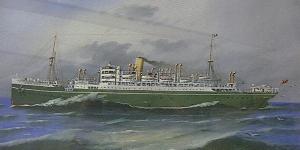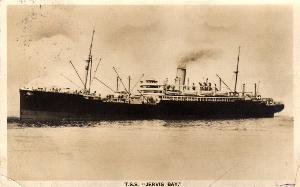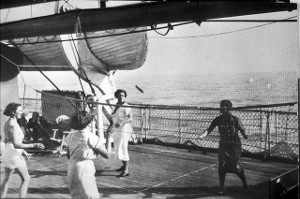
 During the years which immediately followed WWI the
Australian
Commonwealth Line announced that five identical twin-screw passenger-cargo
liners had been ordered from British shipyards for the Australian emigrant
service.
During the years which immediately followed WWI the
Australian
Commonwealth Line announced that five identical twin-screw passenger-cargo
liners had been ordered from British shipyards for the Australian emigrant
service.
The ships were specifically designed to operate a schedule of monthly
departures between the ports of London, Fremantle, Adelaide, Melbourne, Sydney
and Brisbane. Their advent was supposed to rid the Commonwealth fleet of the
rather 'mixed bag' of vessels in current use.
The new steamers, all completed during 1921 and 1922, were each named after
a bay situated in each of the five federal States served by the company. As
such they became known throughout Australia as the 'Bay ships'. Three of these
vessels were constructed by the famous Vickers, Armstrongs organisation at
Barrow. They were Moreton Bay, Hobsons Bay and Jervis Bay,
listed by their respective entries to service.
The other two 'Bays', the slightly different Largs Bay and
Esperance Bay, were constructed by the Clyde-side yards of William
Beardmore & Company.
The Commonwealth Line set a precedent for the 14000 tons quintet by
registering each ship in the State from which their names were derived. The
three Barrow-built ships
featured a
similar passenger configuration of a tiny 12 passenger first class (mainly
for Government officials) and a more spacious complement of over 700 third
class passengers.


An interesting entry in the Report of the Medical Officer of Health for Port of London, 1925. showing fumigation of the Jervis Bay. See more details here...
Largs Bay was the second 'Bay' to enter service. She followed
Moreton Bay into service during January 1922. Esperance Bay (1)
was the second to last, upon her entry to the Brisbane route during August
1922.
The Clyde-built 'Bays' were very similar to their English constructed
sisters, although certain minor details differed. Although not immediately
discernible, the hulls of Largs Bay and Esperance Bay were three
feet greater in length. They also possessed different propulsion machinery.
Their steam turbines were of Parsons manufacture, as opposed to the in-house
Vickers units specified south of the border.
The Clyde-built 'Bays' suffered from the same mismanagement as their sisters
during the early days of their Australian Commonwealth Line operations. Their
ownership passed to the Kylsant group of companies during 1928, after which
they served as units of the reorganised Aberdeen & Commonwealth Line under
management of White Star and George Thompson Company auspices. At this time
they received the deep green hull livery by which they are perhaps best
remembered.
 Also
during 1928 the 'Bays' registry was transferred to London. Largs Bay had
previously been registered at Adelaide (capital of South Australia, where
Largs Bay is situated) and Esperance Bay (1) at Fremantle
respectively. During a refit in 1931 the ships had their select 12-passengers
first class merged with the lesser accomodation. The whole configuration was
altered to cater for 550, should the need arise, by installing temporary
module-like prefabricated cabins within the upper hold spaces.
Also
during 1928 the 'Bays' registry was transferred to London. Largs Bay had
previously been registered at Adelaide (capital of South Australia, where
Largs Bay is situated) and Esperance Bay (1) at Fremantle
respectively. During a refit in 1931 the ships had their select 12-passengers
first class merged with the lesser accomodation. The whole configuration was
altered to cater for 550, should the need arise, by installing temporary
module-like prefabricated cabins within the upper hold spaces.
The sole remaining Clyde-built 'Bay' remained in service for the Aberdeen &
Commonwealth Line upon the Southampton/Brisbane route, in consort with
Moreton Bay, Esperance Bay (2) and Jervis Bay, until the
outbreak of WWII.

Excerpt from
Ships
That Passed |
 The
accompanying photo was forwarded by Ian Todd, Scotland. His story...
"My father Thomas Wright Todd joined the Jervis Bay on 23 October 1934
as 6th Engineer. He completed 6 voyages, all to Australia before coming ashore
as the 5th Engineer on 15 January 1937. The picture was taken from Sydney
Harbour Bridge I believe sometime in 1936. On the original you can make out
some of the crew on the aft deck in their whites. I suppose my father might be
one of them. He was subsequently called back up for War Service in 1942 serving
on a variety of merchant men before being discharged in 1946. "
The
accompanying photo was forwarded by Ian Todd, Scotland. His story...
"My father Thomas Wright Todd joined the Jervis Bay on 23 October 1934
as 6th Engineer. He completed 6 voyages, all to Australia before coming ashore
as the 5th Engineer on 15 January 1937. The picture was taken from Sydney
Harbour Bridge I believe sometime in 1936. On the original you can make out
some of the crew on the aft deck in their whites. I suppose my father might be
one of them. He was subsequently called back up for War Service in 1942 serving
on a variety of merchant men before being discharged in 1946. "
 |

Breakfast Menu, 1939






















